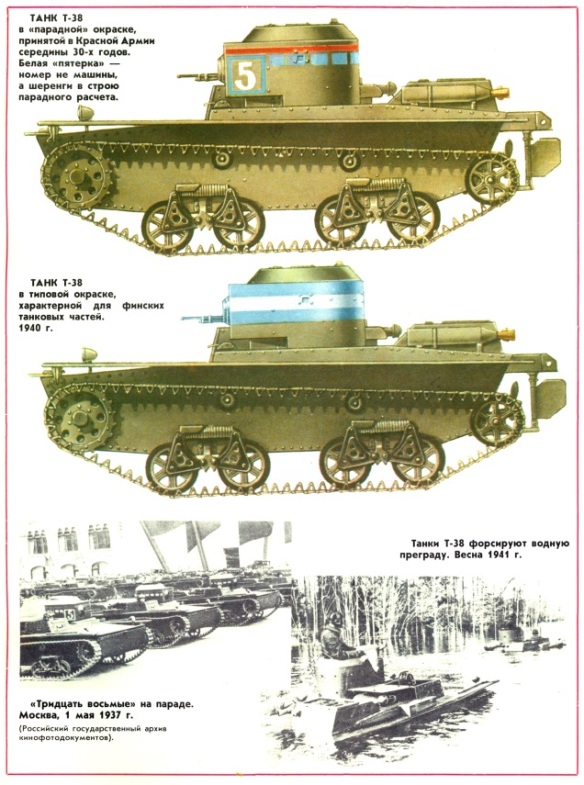Another area in which British designs had a strong influence on early Soviet tank types was the development of amphibious light armoured vehicles. The series of tank types bought from Vickers Armstrong/Carden Loyd in 1929 had included the innovative VCL Amphibian tank. A light 3.04 tonne (3 ton) vehicle with a machine gun, it could cross small waterways. The Amphibian inspired a generation of Soviet amphibious tank designs, until the demands of war terminated production.
In 1931 a design team at Zavod Nr 47 near Moscow simultaneously developed two prototype amphibious tanks which were based on the VCL design. The T-33 (originally designated the MT-33) had a crew of two and weighed 3.04 tonnes (3 tons). The T-41 was similar in design and armament, carrying a single, turret mounted DT 7.62mm (0.3in) machine gun, with the main difference being in the body, which was slightly larger for greater buoyancy when crossing a water way. Unsatisfactory performances during trials of the two vehicles, and especially problems with the T-41 ‘s waterproofing and the unsuitability of the VCL suspension, led to the development of a further alternative prototype.
The T-37 was a refinement of the earlier models rather than a radically new design. A modified Horstmann spring coil suspension was adopted with improved tracks and drive system for the single propeller. The hull was strengthened and sheet-metal track guards encasing balsa-wood floats were added for extra buoyancy. These modifications were dispensed with as the T-37 came to the end of its production run in 1936. Waterproofing problems persisted because of the hull’s river construction, but this was on the whole overcome in 1935 by welding together and riveting the tank’s armour plates.
The durability of the T-37 design was shown during rigorous trials in 1933 when over 11 days, 7 T-37s travelled 1126km (700 miles), over 965km (600miles) in water. Like most Soviet tank designs, dedicated command variants were constructed, which were termed T- 37TU. A production run of 1200 vehicles was completed between 1933 and 1936. They served in a reconnaissance role with tank, mechanized and cavalry units in all Red Army operations up to 1942.
THE T-38
Plans to modernize the T-37 in the mid-1930s led to such extensive changes by the Zavod Nr 37 team that it was decided to designate it T-38. Improved hull design gave a lower profile and a decrease in weight. Coupled with a new suspension, wider tracks and improved steering, the T-38 was easier to handle, more manoeuvreable, and altogether a better swimmer than the T-37 . Armament, however, remained the same as the T-37, although a 20mm (0.78in) gun fitted in a low turret with the driver was rejected because it restricted his ability to control the vehicle.
In addition to its reconnaissance role, the T-38 underwent several experimental combat roles. During the 1936 Kiev Military District manoeuvres, a number of T-38 and T-27 vehicles were air-landed deep behind enemy lines in a radical test of the potential of airborne forces. In 1940, several T-38s were adapted for radio control and fitted with explosives for use against enemy bunkers. An estimated 1300 vehicles were manufactured between 1937 and 1939.
THE T-40
Common to many pre-war Soviet tank designs, the T-37 and T-38 proved to be too vulnerable to heavy machine-gun fire and shell splinters. This problem had been foreseen as early as 1938, when a special research department at Zavod N r 37, led by chief engineer N. A. Astrov, was instructed to design two variants of a new light scout tank, of which one was to be amphibious. Several prototypes of the amphibious vehicle (initially designated T-30A) were in trials between July and August 1939. Once orders to rectify defects were complied with, the vehicle was accepted for production and service as the T-40 on 19 December 1939.
The vehicle had a torsion suspension and, in the water, was driven by a single propeller and steered by two rudders at the rear. A more powerful engine, hermetically sealed hatches and a better-shaped front with a special water deflector enabled the T-40 to cross wider rivers with strong currents, like the Dniepr and Dnestr (although as a precaution the crew were supplied with lifebelts). Despite ambitious plans, production was low, and in 1940 the addition of extra armour and the need to increase tank production led to the non amphibious T-30B prototype being given priority, also as the T-40.
At 6.09 tonnes (6 tons), both T-40 variants weighed twice the weight of the T-37 and T-38, but the cause of this increase – welded thicker 14mm (O. Sin) bulletproof armour – did not make it any less vulnerable in battle to light weapons than they were. The inability of its 12.7mm (O. Sin) DShK main gun, while firing armour-piercing rounds, to penetrate armour 16mm (0.62in) above 300m (984ft) also restricted its combat worthiness. Possibly if the T-40 had been used in its reconnaissance role, its armour and gun might just have proved sufficient, but the tendency of Soviet commanders to use them like regular tanks led to heavy losses in 1940 and 1941.
